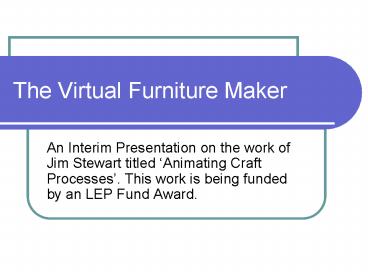The Virtual Furniture Maker - PowerPoint PPT Presentation
1 / 16
Title:
The Virtual Furniture Maker
Description:
The Virtual Furniture Maker. An Interim Presentation on the work of Jim Stewart ... Went on a taster session. Got totally confused ... – PowerPoint PPT presentation
Number of Views:98
Avg rating:3.0/5.0
Title: The Virtual Furniture Maker
1
The Virtual Furniture Maker
- An Interim Presentation on the work of Jim
Stewart titled Animating Craft Processes. This
work is being funded by an LEP Fund Award.
2
Where Did This Start?
- Traditional Lectures
- Finding a way to give lecture notes to students
that engaged interaction - SCPE
- Blackboard Training
- Whats happened in the last couple of years My
Journey
3
Original Analysis of What I Did
- Vocational Education -delivery via demonstration
- Talked and talked
- Set pace for group
- Set agenda and program for learning
- Made the assumption that the way I was taught
best suited the context - Found out what students wanted and how
4
Problem of Teaching Process
- Interaction (F2F)
- Multi-tasks (Concept)
- Movement (Reality)
- Three dimensional (length, width and depth)
- But actually teach in the fourth dimension
(time). - Time critical
5
What Happened Next?
- Asked question What is Blackboard/VLE
- Found out that Skippy was in fact spelt SCPE and
not a bush kangaroo. - Went on a taster session
- Got totally confused
- Realised that there might be a whole real time
world of open access that generationally I was
ill equipped to use.
6
Problems of Using VLE
- Having to learn a whole new application software
- Same problem of comprehending what it is you are
doing can be viewed instantly by others. (Like
wrestling emails big brother) - Internet not my instinctive choice for research
- Many students are much more advanced in their
understanding - Social Networking
7
What are the Options Available to Practitioners
- Informal
- Surf and Turf
- The more you use computer applications the better
you get???? - Flexible time constraints
- Formal
- Back to School
- Short course in subject
- Application specific training
- Qualification
- Focused time usage
8
Where do you start with eLearning
- Levels of influence in ICT Teaching Saunders
(2000), - Use of computers to produce handouts and overhead
transparencies - Then use of email to communicate class/course
specific information - Then move to on-line student discussion forum and
electronic slide presentations. - Above, plus on-line subject-specific information
resource, such as lecture notes and interactive
tutorials - The above, plus on-line video clips, sound files
and submission of course work, on-line
assessment, capability to maintain student
records, computer conferencing. - The above, plus interactive video-conferencing,
broadcasting - Virtual Learning Environment enabling
participants to enter a program as a character
and experience real life situations.
9
Formulating a Model
- The Five Stage Framework Salmon (2002)
10
What Have I Used Blackboard For
- Weekly folders
- Module Design Briefs
- Course Documents
- Background Resources
- Assignments
- Announcements
- Communications
- Suggested Reading
- Test Area
- Module Feedback
- Feedback on eLearning
- Example of what I have used it for
- Online Test
11
Why am I doing this
- As a user of machinery, tools and equipment in my
everyday teaching it seems quite natural to me to
in the words attributed to Pablo Picasso always
doing that which I can not do, in order that I
may learn how to do it.. This statement seems to
typify why I, as a non-conversant in the
technologies available to my students, embarked,
on the exploration of this new subject area.
12
Next Level of Development
- Animation
- Use of a technique that looks at individual
activities (or frames) that could convey
succinctly the whole process. - Use of Video
- This would enable commentary to offer insight to
the strategies employed in the process - Video Offers a real time approach
- Conversely it allows multiple edits to display
the correct procedure, and end quality to
artefact - Put Large Screens and online access into
workshops
13
Process of Inclusion
- Seek student Involvement
- Forming student committee
- Achieving consensus?
- Identification of perceived need
- Check to see that they felt it needed doing?
- Reviewing good practice elsewhere
14
Process of Making Films
- Educational videos have been done before
- How do you make them relevant?
- New Yankee Workshop?
- The New Yankee Workshop
15
Where am I Now?
- Formed student advisory group
- Discussed and identified the animations/videos to
be made - Discussed in principle what is involved with this
type of film - Started to Storyboard the first content area
- Need to script the narrative
- Decided on single camera
- Currently purchasing basic camera equipment
- Need to work out how and whom will shoot film
- Streaming and repository
16
Summary of Conclusions Drawn to date
- Student Focus
- Validity
- Base line
- Mapping
- Accessibility
- Focus
- Is it of use
- Professional and Pedagogical focus
- Constructivist Approach?
- Can I profile past students
- Can I correlate past and future results
- Is it the best use of resource?










![65 Side Businesses You Can Start [Small Biz Trends] PowerPoint PPT Presentation](https://s3.amazonaws.com/images.powershow.com/8755331.th0.jpg?_=20170123045)




















